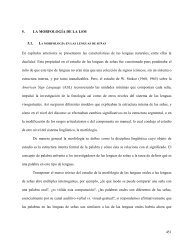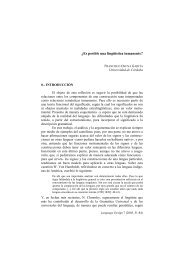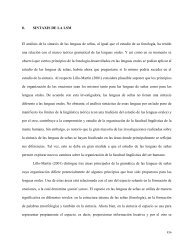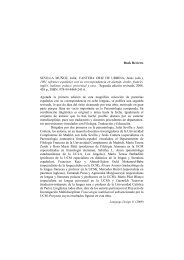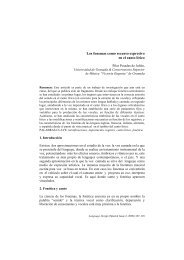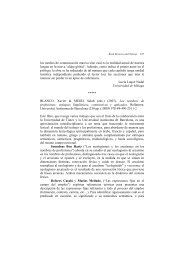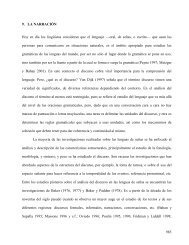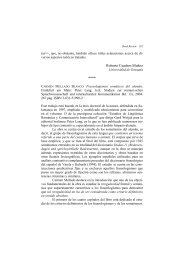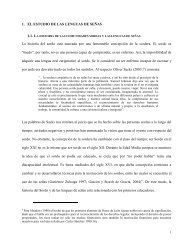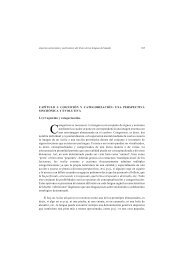Relaciones argumentativas en expresiones idiomáticas
Relaciones argumentativas en expresiones idiomáticas
Relaciones argumentativas en expresiones idiomáticas
- No tags were found...
You also want an ePaper? Increase the reach of your titles
YUMPU automatically turns print PDFs into web optimized ePapers that Google loves.
Susana Creus 42FRASER, B. 1979 “The Non-uniqu<strong>en</strong>ess of Semantic Solutions. Polisemy”.Linguistics and Philosophy, n. 3, pp. 143-184.FRASER, B. 1970 “Idioms within a Transformational Grammar”. Foundations ofLanguage, Cambridge, MA, v.6, p. 22-42, (apud. Čermák 1988:413-438).GIBBS, R. W. Jr.; NAYAK N. P. 1989 “Psycholinguistic Studies on theSyntactic Behavior of Idioms”. Cognitive Psychology, n. 21, pp. 100-138.GIBBS, R.W. Jr.; O’BRIEN, J. E. 1990 “Idioms and M<strong>en</strong>tal Imagery: TheMetaphorical Motivation for Idiomatic Meaning”. Cognition, n. 36, pp.35-68.GIBBS, R. W. Jr. 1993 “Why Idioms Are Not Dead Metaphors”. In: Idioms,Processing, Structure, and Interpretation. Hillsdale: Lawr<strong>en</strong>ce ErlbauAssociates.GLUCKSBERG, S. 1993 “Idiom Meanings and Allusional Cont<strong>en</strong>t”. In: Idioms,Processing, Structure, and Interpretation, Cacciari; Tabossi. Hillsdale,New Jersey: Lawr<strong>en</strong>ce Erlbau Associates.GONZÁLEZ REY, I. 2002 La phraséologie du français. Toulouse: PressesUniversitaires du Mirail.GUERRA SALAS, L. 1997 La ruptura de la frase hecha <strong>en</strong> el l<strong>en</strong>guajeperiodístico y publicitario. In: Paremia, Madrid: Asociación CulturalIndep<strong>en</strong>di<strong>en</strong>te, n. 6.JACKENDOFF, R. 1997 The Architecture of the Language Faculty. Cambridge,MA: MIT.JACKENDOFF, R. 1995. “The Boundaries of the Lexicon”. In: Everaert, VanDer Lid<strong>en</strong>, Sch<strong>en</strong>k, Schreuder (Org.). Idioms: Structural andPshychological Perspectives Hillsdale: Lawr<strong>en</strong>ce Erlbaum, pp. 133-165.KLEIBER, G. 1989 “Généricité et typicalité”. Le français moderne, n. 57, 127-153.KLEIBER, G. 2000 “Sur le s<strong>en</strong>s des proverbes”. Langages, Paris: Larousse, n.139, pp. 39-58.MARÍN RUBIALES, A. 1999 “Léxico y cognición <strong>en</strong> los modismos des<strong>en</strong>timi<strong>en</strong>to”. Paremia, Madrid: Asociación Cultural Indep<strong>en</strong>di<strong>en</strong>te, n. 8,pp. 323-326.NUNBERG, G.; SAG, I.; WASOW, T. 1994 “Idioms”. Languages, Stanford,CA, v. 70, n.3, pp. 491-38.NUNBERG, G. 1979 “The non-uniqu<strong>en</strong>ess of semantic solutions. Polisemy”.Linguistics and Philosophy, v. 3, n. 2, 143-184, (apud. Cacciari1993).RACCAH, P-Y. 1987 “Modelling Argum<strong>en</strong>tation and Modelling withArgum<strong>en</strong>tation”. Argum<strong>en</strong>tación. Barcelona, n. 4, pp. 447-483.RACCAH, P-Y. 1990 “Signification, s<strong>en</strong>s et connaissance: une approchetopique”. Cahiers de Linguistique Francaise, n. 11.RACCAH, P-Y. 1995 “Argum<strong>en</strong>tation and Natural Language: Pres<strong>en</strong>tation andDiscussion of Four Foundational Hypotheses”. Journal of Pragmatics. v.24.



